Tirta Empul, a sacred temple in Bali, invites you on a journey through history, culture, and spirituality. This ancient site holds a special place in the hearts of Balinese Hindus and visitors alike, offering a glimpse into the island’s rich traditions and beliefs.
Immerse yourself in the captivating story of Tirta Empul, where legends and rituals intertwine to create a tapestry of faith and devotion. Discover the architectural wonders of the temple, from its serene bathing pools to its intricate shrines, each element imbued with profound symbolism.
History and Cultural Significance
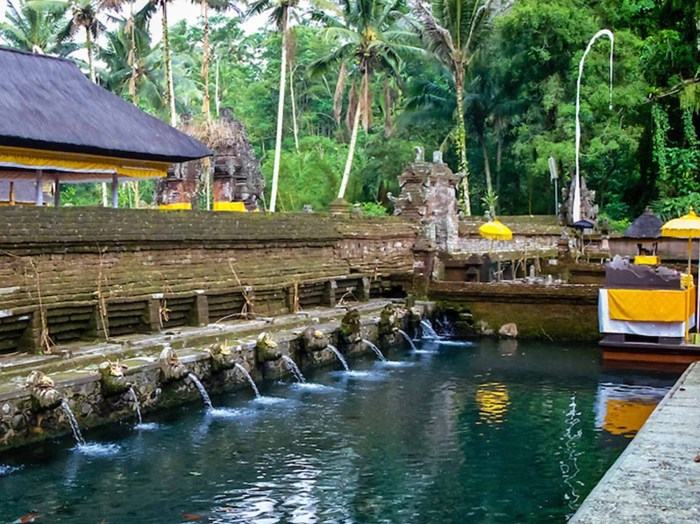
Tirta Empul, meaning “Holy Spring of the Temple,” is an ancient water temple in Bali, Indonesia, renowned for its spiritual and cultural significance. It holds a pivotal role in Balinese Hinduism, serving as a pilgrimage site and a source of holy water for purification rituals.
Tirta Empul is a significant water temple in Bali, renowned for its sacred springs and purification rituals. If you’re planning a trip to Bali, consider booking your accommodation at Fraser Residence Menteng Jakarta , a luxurious hotel in Jakarta. After exploring the bustling city, return to Tirta Empul for a serene experience, immersing yourself in its spiritual ambiance.
The temple’s origins trace back to the 10th century, when a revered sage named Mpu Kuturan consecrated the site. Legends narrate that the holy spring emerged from the ground after Lord Indra struck it with his thunderbolt, creating a pool of rejuvenating water that granted immortality to those who bathed in it.
Religious and Cultural Importance
Tirta Empul holds profound religious significance for Balinese Hindus. The temple is dedicated to Vishnu, the preserver god, and his consort Dewi Danu, the goddess of water. Devotees believe that the holy water possesses purifying and healing powers and seek blessings for health, prosperity, and spiritual growth.
After visiting the sacred Tirta Empul temple, unwind at Swiss Belinn Kemayoran , a modern hotel just a short drive away. Swiss Belinn Kemayoran offers comfortable accommodations, a rooftop pool, and a restaurant serving delectable Indonesian cuisine. Afterward, return to Tirta Empul for a purifying bath in its holy waters, completing a day filled with both spiritual and physical rejuvenation.
The temple complex comprises several bathing pools, each with a specific purpose. The main bathing pool, known as “Pancuran Sudamala,” features 30 spouts representing the gods and goddesses of the Hindu pantheon. Pilgrims immerse themselves in these waters to cleanse their sins and receive divine blessings.
Pilgrimage and Rituals
Tirta Empul is a revered pilgrimage site for Balinese Hindus, who visit the temple for various religious ceremonies and festivals. The most significant event is the annual “Melasti” ceremony, where thousands of devotees gather to purify themselves in the holy water before the Nyepi Day, a day of silence and meditation.
Pilgrims perform elaborate rituals at the temple. After bathing in the sacred pools, they pray at the shrines and offer offerings of flowers, incense, and fruit. The temple also serves as a venue for traditional Balinese dances and ceremonies, adding to its vibrant cultural ambiance.
Architectural Features
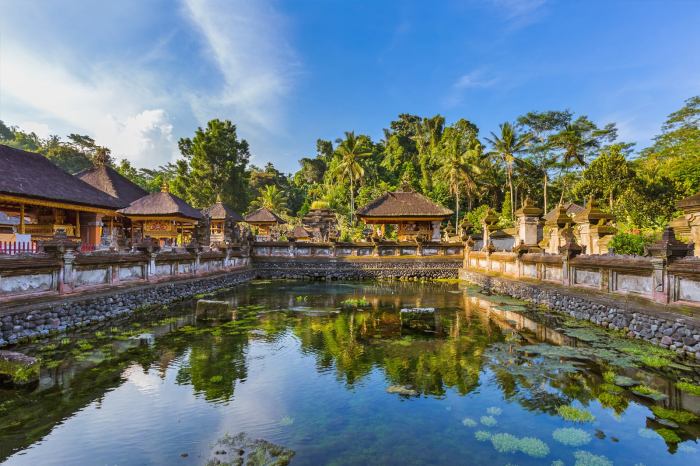
Tirta Empul’s architectural design reflects its religious and cultural significance, incorporating elements that symbolize purification and spiritual renewal.
The temple is laid out on a north-south axis, with the main bathing pools located in the southern part of the complex. The layout follows the traditional Balinese temple architecture, known as “Tri Mandala,” which divides the temple into three sections: the outer courtyard (Jaba Pura), the middle courtyard (Jaba Tengah), and the inner courtyard (Jeroan).
Outer Courtyard (Jaba Pura), Tirta empul
The outer courtyard is the entrance to the temple and contains several structures, including:
- Candi Bentar: A split gate that marks the entrance to the temple.
- Wantilan: A large open pavilion used for community gatherings and ceremonies.
- Taman Sari: A small garden with a fountain.
Middle Courtyard (Jaba Tengah)
The middle courtyard is where the main bathing pools are located. There are three pools in total:
- Pemedal Agung: The largest pool, used for general purification.
- Pemedal Alit: A smaller pool, used for purification before entering the inner courtyard.
- Pancuran Suci: A sacred fountain with 30 spouts, each representing a different god or goddess.
Inner Courtyard (Jeroan)
The inner courtyard is the most sacred part of the temple and contains several shrines, including:
- Meru Tumpang Solas: A nine-tiered pagoda that represents Mount Meru, the sacred mountain of the gods.
- Padmasana: A lotus throne that symbolizes the seat of the gods.
- Kori Agung: A large gate that separates the inner courtyard from the rest of the temple.
The architectural design of Tirta Empul is not only aesthetically pleasing but also deeply symbolic, representing the journey of purification and spiritual renewal that is central to the Balinese Hindu faith.
Rituals and Ceremonies
Tirta Empul is a sacred water temple where Balinese Hindus perform various rituals and ceremonies. These rituals are deeply rooted in Balinese Hinduism and have been passed down through generations.
The most important ritual at Tirta Empul is the purification ritual, known as melukat. During this ritual, devotees bathe in the sacred spring water to cleanse themselves of impurities and seek blessings. The water is believed to have healing properties and is said to bring good luck and prosperity.
Tirta Empul is a popular Hindu temple in Bali, Indonesia, known for its holy spring water. The water is believed to have healing properties, and many people visit the temple to bathe in it. In contrast to the serene atmosphere of Tirta Empul, the Marina Bay Sands Singapore is a modern architectural marvel that offers a luxurious and vibrant experience.
While Tirta Empul is a place of spiritual significance, Marina Bay Sands is a symbol of Singapore’s economic growth and cosmopolitan lifestyle. Despite their contrasting nature, both destinations offer unique and memorable experiences to visitors.
Purification Ritual
The purification ritual involves the following steps:
- Devotees enter the temple compound and purchase offerings from the temple priests.
- They then proceed to the purification area, which consists of a series of spouts.
- Devotees line up in front of the spouts and pray.
- They then pour water over their heads from each of the spouts, starting with the spout on the left and moving to the right.
- After bathing, devotees make offerings to the gods and pray for blessings.
The purification ritual is believed to cleanse devotees of both physical and spiritual impurities. It is also believed to bring good luck and prosperity.
Other Ceremonies
In addition to the purification ritual, Tirta Empul is also used for other ceremonies, such as:
- Weddings
- Cremations
- Temple festivals
These ceremonies are all important events in the lives of Balinese Hindus, and Tirta Empul is considered a sacred place to hold them.
Healing Properties
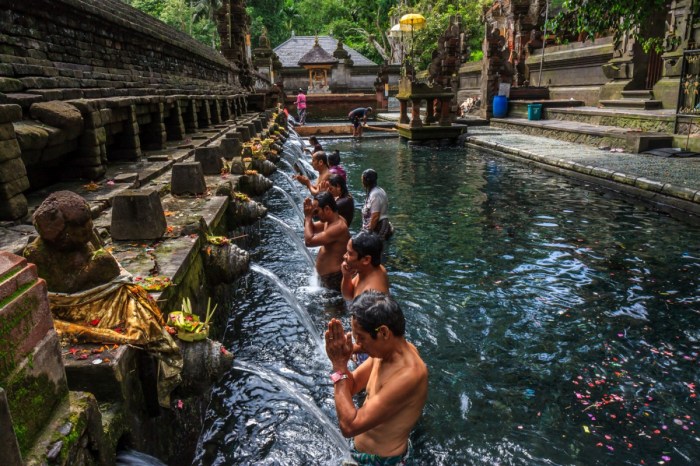
Tirta Empul’s sacred waters are renowned for their purported healing properties, attracting pilgrims and visitors alike seeking physical and spiritual rejuvenation.
Scientific research and anecdotal evidence support these beliefs. Studies have shown that the water contains high levels of minerals, including calcium, magnesium, and potassium, which are essential for overall health and well-being.
Anecdotal Evidence
- Many visitors report experiencing relief from various ailments after bathing in the holy spring, including skin conditions, digestive issues, and chronic pain.
- Some claim that the water has helped them overcome fertility problems, while others attribute it to improved sleep and reduced stress levels.
Tourism and Preservation
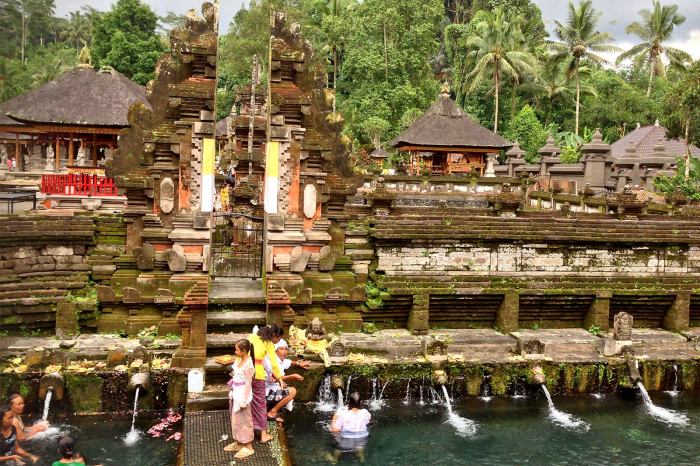
Tourism plays a significant role in the preservation and promotion of Tirta Empul. The temple attracts a large number of domestic and international visitors, generating revenue that can be used to fund restoration and maintenance projects.
However, increasing visitor numbers also present challenges. The influx of tourists can lead to wear and tear on the temple’s structures and facilities, as well as environmental degradation. It is important to implement sustainable tourism practices that can help protect the temple’s cultural and environmental integrity.
Sustainable Tourism Practices
- Limit the number of visitors allowed in the temple at any given time.
- Educate visitors about the importance of respecting the temple’s cultural and environmental significance.
- Provide designated areas for visitors to rest and eat, to minimize impact on the temple’s sacred spaces.
- Encourage visitors to use public transportation or tour operators that prioritize sustainability.
- Promote the use of biodegradable and reusable materials, and discourage the use of single-use plastics.
Epilogue: Tirta Empul
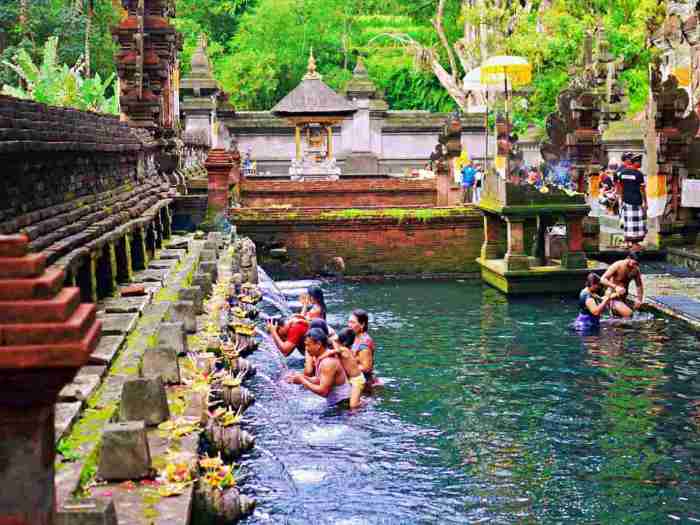
Tirta Empul stands as a testament to the enduring power of faith and the healing properties of nature. Its waters continue to attract pilgrims and tourists from far and wide, seeking solace, purification, and a connection to the divine. As you leave the temple grounds, carry with you the spirit of Tirta Empul, a reminder of the sacredness that surrounds us.
FAQ Compilation
What is the significance of Tirta Empul in Balinese Hinduism?
Tirta Empul is a holy temple where Balinese Hindus perform purification rituals and make offerings to the gods. It is believed that the temple’s waters possess healing properties and can cleanse both the body and soul.
What are the architectural highlights of Tirta Empul?
The temple features a series of bathing pools, each with its own unique purpose. There are also numerous statues and shrines dedicated to various Hindu deities.
What rituals are performed at Tirta Empul?
Pilgrims visit Tirta Empul to bathe in the sacred waters and make offerings to the gods. They believe that these rituals can bring good health, prosperity, and spiritual purification.
Is there any scientific evidence to support the healing properties of Tirta Empul’s waters?
While there is no definitive scientific evidence, many people believe that the waters of Tirta Empul have healing properties. Some studies have shown that the water contains minerals that may be beneficial for health.